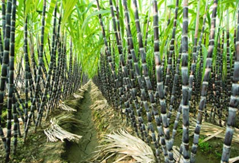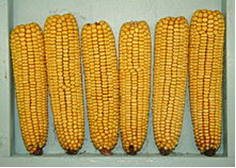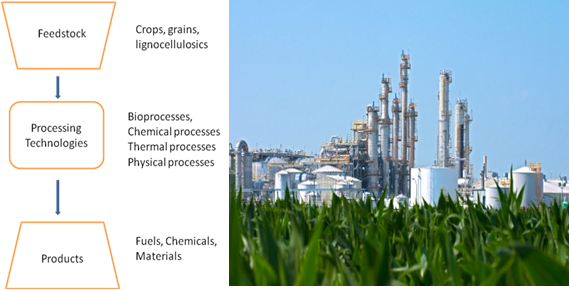Bioalcohol
Today global ethanol production is over 50 billion litres per year (Ref: H.S. Ray ,Everyman's Science) and bioethanol segment represents nearly 85% of the global market.
Ethanol is produced from sugar/starch from crops such as sugarcane and corn respectively. Sugar contained in these crops is fermented anaerobically by micro-organisms leading to first generation of biofuels (bioalcohols like bioethanol). The alcohol can be an additive to petrol/gasoline and can thus help in conservation of fuels. Alcohol as a fuel additive can be used into existing internal combustion engines and distribution infrastructures also need not be altered. Some other sources of ethanol include wheat, sugar beet, and sweet sorghum.


Image Ref : Kerala Agricultural University Image Ref : Wikipedia

Image Ref : ICRISAT
Ethanol has excellent fuel properties for spark ignition internal combustion engines. It has high octane value and is less toxic. Bioethanol is mainly produced in USA and Brazil. Brazil is the largest exporter of bioethanol. Since inception of Brazilian ethanol program ProÁlcool ethanol production (from sugarcane) has increased 30 times, yield per hectare has increased by 60%, and production costs have declined by 75%. Scientists, business people, government officials came together in this program which was highly regulated and received high subsidies. 90% of ethanol is retained in the country for transportation and rest is exported.
Sweet Sorghum
Sorghum [Sorghum bicolor (L.) Moench] is a hardy, adaptive and multipurpose crop providing grain for human consumption, stalks/leaves for animal fodder and the juice of the stalks for fuel. Ethanol can be produced form juice extracted from stems similar to sugarcane. Since its non-food component is used to generate ethanol it does not hamper food production. Cultivation of the crop needs less inputs and being a C4 plant, biomass development is rapid. It has high sugar content and is an ideal biofuel crop. In Africa and America it is grown traditionally for production of syrups. ( Ref: Sweet Sorghum for biofuel, ICRISAT). Research efforts are underway at ICRISAT for introgression of low lignin lines into varieties elite for biomass. Ethanol production from Sweet sorghum stalk is highly efficient and causes less pollution compared to ethanol production from sugarcane.
Constraints/ Challenges for fist generation of bio-alcohol
These include: Protests over use of land for biofuels because land is needed for agricultural production for man and animals, Diversion of corn and sugarcane for biofuel consumption and apprehensions about shortages for human and animal consumption (Food vs. fuel resulting into higher food price). Need for energy for irrigation and production of fertilizers in production of biofuel crops, Mismatch between centres of biofuel production and centres of maximum usage and energy needs for transportation etc. etc. (Ref : Article by H.S. Ray ,Everyman's Science). Not having enough biomass is also one of the major constraints. (Ref: Review by TIFAC, 2010).
Generation of alcohol is a low temperature biochemical conversion process driven by enzymes. It involves hydrolysis (of starch) to sugar and its anaerobic conversion to alcohol.
Second generation bioalcohols
Cellulose is a polymer of glucose found in plant cell walls. If cellulosic biomass can be efficiently converted into sugar then wider options for biomass feedstocks can be utlized. (Ref: H.S. Ray ,Everyman's Science). In India we can use the stalks of wheat, rice, corn, pine corn, pine, needles, bamboo, sugarcane tops etc as these are potential non-food, non – feed resources. (Ref : Review by TIFAC, 2010). High quality, inexpensive biomass should be available in large quantities to make the technology viable. Dedicated energy crops like perennial grasses can be grown on marginal lands to supply feedstock.
The technology is complex in comparison to first generation of biofuels as an additional 'pretreatment' step involving methods like thermochemical treatment of biomass to facilitate further conversions. Cell walls are tough barriers made of polymers like cellulose and hemicellulose (C6 and C5 sugars) which are difficult to ferment. The additional processing is required to break structures down for better exposure and to separate lignin/hemicelluloses from cellulose.
Biorefinery (Ref : Biorefinery presentation - university of Oklahoma)
It's a large system of processing units, similar to petroleum refineries but operates on biomass. All the steps of processing biomass to fuels and chemicals are carried out in a biorefinery. Since it has multiple plants in one location transportation costs are saved. Biorefinery produces fuels and multiple chemicals from biomass. In this biochemical conversion process several steps viz. pretreatment, enzymatic hydrolysis and fermentation are integrated.

Image Reference: Epure
Biorefineries can produce a variety of bio-based products (food, feed, materials, chemicals) and bioenergy (fuels, power and/or heat) catering to full Bio-based Economy. This would facilitate maximum biomass conversion frequence reducing dependence on raw material and strengthening various sectors like agriculture, forestry, chemicals and energy. ( Ref : Review by TIFAC, 2010).
Research Focus
- Rapid development of biomass, especially engineered towards production of cellulose. QTL mapping, molecular markers will enhance biomass development.
- Metabolic engineering of microbes for higher tolerance of fuel metabolites e.g. generating ethanol tolerant Saccharomyces cerevisium. Example: NREL, USA has developed an engineered strain of Zymomonas mobilis to ferment both cellulose and hemicellulose. (Ref : NREL article on biomass economy)
- Pretreatment of biomass biochemically/ thermochemically.
- Removal of hemicelluloses to expose cellulose to hydrolyzing enzymes
Chemicals: A collaborative venture of two major companies began production of polylactic acid plastic made from biomass for clothing and packaging. In addition to ethanol, the sugars, or intermediate. Sugars as well as breakdown products can be processed into multiple products. Lignin, the third most major component of biomass, can also be processed into variety of chemicals. (Ref : NREL article on biomass economy).
Bioethanol in India
India's first biorefinery is set up in Karnataka by Godavari Sugar Mills Ltd (GSML), Mumbai with technical support from National Chemical Laboratory (Pune). It is based on sugarcane bagasse as biomass feedstock. To get a clear(er) picture on sustainable biofuel production it is necessary to understand availability of biomass and its storage, transportation and procurement arrangements. India has over 140 M ha arable land is estimated to produce over 700 MTA biomass. 50 M ha of this arable land is under mono cropping and therefore provides for potential production of short cycle cellulosic biomass. ( Ref : Anil Dhussa, Ministry of Renewable Energy). A study by NIIST and TIFAC indicates that, due to shortage of cattle fodder in India, biomass from non-fodder crops should be focused for biofuel production e.g. sugarcane tops, crop residues of cotton, chilli, pulses, oilseeds, bamboo etc which are typically burnt in fields or homes for domestic energy needs. ( Ref : Review by TIFAC, 2010).
India already has in place infrastructure to produce over 4000 Million litres of bioethanol from molasses. Inadequate supply and lower purchase price of ethanol has been a constraint to successfully achieve blending targets (Ref: MNRE report available in EAI website, Times of India, June 2012). Competition with portable alcohol, excessive dependence of sugar cane are some of the other constraints.
Examples of ongoing Research on bio-alchol technology ( Ref : MNRE Report)- (i) Isolation and identification of multiple microbial strains producing alcohol. Zymomonas (Isolated and engineered) have been found to be highly suitable for alcohol production from cellulosic waste. (ii)Pilot plant for ethanol from cassava starch is being developed and studies on fermenting enzymes are underway. (Ref : Tamilnadu Agricultural University). CTCRI, Kerala is actively involved in cassava bio - prospecting. (iii) Ethanol stove (ethanol + water) is designed, fabricated and developed. (iv) Sweet sorthum research at ICRISAT ( Ref ICRISAT). Tata has invested in sweet sorghum ethanol plant. (Ref: MNRE report available in EAI website, Times of India, June 2012).
Bioalcohol Technology in Pune
VSI conducted research on Effect of aeration on production of bioglycerol by Hanensula anomala, an osmophilic yeast strain. Glycerol and othe polyols from sugarcane molasses could, if produced indigenously save us costly imports ( Ref: Patil and Sastri 2000).
Alcohol technology group at Vasantdada Sugar Institute (Ref : VSI alcohol tech) helps distillery industry improve its effiency and reduce resource utilization through innovative technologies. Their focus areas are: fermentation, distillation & integrated effluent treatment systems. They have developed improved yeast strains and supplied to sugar mills e.g. Saswad sugar mills. This has helped in enhanced concentration of alchol in fermentation broth from molasses. The group actively works to control pollution by effluents from refineries and undertakes performance evaluation of new technologies in the area of fermentation, distillation and distillery effluent treatment.
There are several engineering industries in Pune innovating designs of fermenters for bioethanol production from various biomass feedstocks and for improved microbe efficiency. (Refer: Database table for bioenergy companies). Praj is one of the leading and pioneering company with expertise in bioprocesses, yeast products and engineering. It offers turn key solutions for life-cycle of alcohol production, engineering audits and has globally contributed to multiple plants. It has developed enhancers for alcohol production from multiple resources. (Ref: Praj website). Their in-house research centre Praj Matrix undertakes various research projects including cellulosic bioethanol and chemicals for value addition to biomass technologies. (Ref: Praj Matrix).
Scope for Technologies
- Rapid and inexpensive technologies for analyzing chemical and mechanical properties of raw and processed biomass. An example of such a technology is Near IR spectroscopy based method for biomass analysis.
- Portable equipments for analysis of biomass.
- Technologies that will allow for production of high value/low volume chemicals to balance production of low value/high volume chemicals. This would help in economic viability of biorefineries.
- Technologies to address metal contamination. Biofuels are highly susceptible to destabilization from low level metal contamination which are difficult to control through the supply chain. Metal deactivators can inhibit the catalytic effects of such ions. However these additives should not have adverse effect on efficiency of technology.
Biobutanol
Biobutanol can itself serve as fuel component or can be a precursor to renewable gasoline, diesel etc. It has multiple advantages like higher calorific value, it is less hydrophilic than ethanol less corrosive and can be transported via pipeline using exising infrastructure. Biobutanol can be added to gasoline at higher levels without engine modification.
Production : Biobutanol too is a product of microbial fermentation of feedstocks like sugar, starch or cellulosic. Traditionally it is produced through acetone-butanolethanol (ABE) fermentation process. The process has been modified by researchers. E.g. process developed by the University of Illinois incorporates engineered strain of Clostridium in a system that allows in situ product removal.
Several international and Indian companies are also developing bio-butanol technologies. E.g. Reliance Life Sciences have developed a solvent tolerant strain producing 20 gms/lit of butanol in a single batch process without solvent. ( Ref: Review by TIFAC, 2010).
